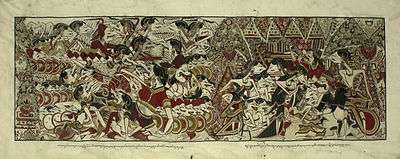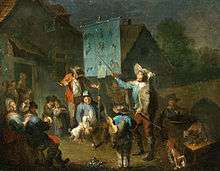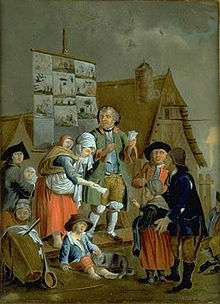Cantastoria
Cantastoria (pronounced [ˌkantaˈstɔːrja]; also spelled cantastorie [ˌkantaˈstɔːrje], canta storia or canta historia) comes from Italian for "story-singer" and is known by many other names around the world. It is a theatrical form where a performer tells or sings a story while gesturing to a series of images. These images can be painted, printed or drawn on any sort of material.
Picture stories in Asia

In 6th-century India, religious tales called saubhikas were performed by traveling storytellers who carried banners painted with images of gods from house to house. Another form called yamapapaka featured vertical cloth scrolls accompanied by sung stories of the afterlife. Nowadays, this Indian traditional art is still performed by Chitrakar women of West Bengal. In Tibet this was known as ma-ni-pa and in China this was known as pien. In Indonesia the scroll was made horizontal and became the wayang beber and employed four performers: a man who sings the story, two men who operate the rolling of the scroll, and a woman who holds a lamp to illuminate particular pictures featured in the story. Other Indonesian theater forms such as wayang kulit, a shadow play, and wayang golek, rod puppetry, developed around the same time and are still performed today.
In Japan, cantastoria appears as etoki (絵解) or emaki (絵巻) in the form of hanging scrolls divided into separate panels, foreshadowing the immensely popular manga, or Japanese comics. Etoki sometimes took the shape of little booklets, or even displays of dolls posed on the roadside with backgrounds behind them. In the 20th century, Japanese candymen would bicycle around with serial shows called kamishibai (紙芝居) where the story was told to a series of changing pictures that slid in and out of an open-framed box. Some kamishibai shows had a peep show element to them, where a viewer could pay extra to peer through a hole and see a supposed artifact from the story.
Picture stories in Europe and the Middle East


In 16th-century Italy, prayers would often be sung in the presence of illuminated scrolls while secular society produced the cantambanco or "singing bench" where a person would stand on a bench point to pictures with a stick.
In Spain up to the 19th century there were blind men with a young "helper" who would make a living by going from town to town where they would display illustrations and the blind man would recite/sing the story, often about truculent crimes, while his helper pointed at the illustration relevant at that point. These were called "romances de ciego" (blind man stories).
The singing bench migrated northward to Central and Northern Europe where it served as sensationalist quasi-news about murder, fires, death, affairs, sex scandals and the like. Performers of such controversial bench songs were seen as vagrants and troublemakers and were often arrested, exiled, or ostracised for their activities.
In Persia, parda-dari (compare India's paradari) banner artists had the foresight to paint a handsome police officer in the corner as a fail-safe against the wrath of police harassment—the narrator would be relating the tale of a hero's exploits and when a cop would appear in the crowd the narrator would point to the cop on the banner and shower the character with flattery in the context of the story.
In Czechoslovakia banner shows were called kramářská píseň. Most of them fell into an oblivion, with the notable exception of a parody song Cannoneer Jabůrek.
In Hungary the term is képmutogatás.
In Germany itinerant balladeers performed Moritat or Bänkelsang (bench song) banner shows for four centuries until the Nazis banned the practice in the 1940s. The German Bänkelsang survives in Bertolt Brecht's The Threepenny Opera (German: Die Dreigroschenoper) and in the performance work of Peter Schumann.
Picture stories elsewhere in the world
In aboriginal Australia storytellers paint story sequences on tree bark and also on themselves for the purposes of performing the tale.
In the 19th century, giant scrolling moving panorama performances were performed throughout the United Kingdom and United States. The 20th century has seen cantastoria employed by the radical art, theater and puppetry movements to tell stories from perspectives outside of the mainstream media, especially by the Bread and Puppet Theater. Elements of picture storytelling can also be seen in the portable mural-posters of the Beehive Collective.
References
- Mair, Victor H., Painting and Performance: Chinese Picture Recitation and its Indian Genesis. Honolulu: University of Hawaii Press, 1988.
- Too Many Captain Cooks, film by Penny McDonald starring Paddy Wainburranga
- Mariangela Giusti and Urmila Chakraborty (editors), Immagini Storie Parole. Dialoghi di formazione coi dipinti cantati delle donne Chitrakar del West Bengal, 2014, ISBN 978-88-97683-39-1
